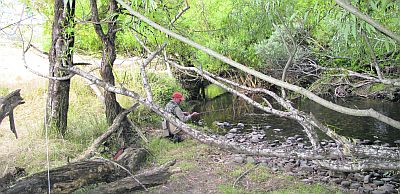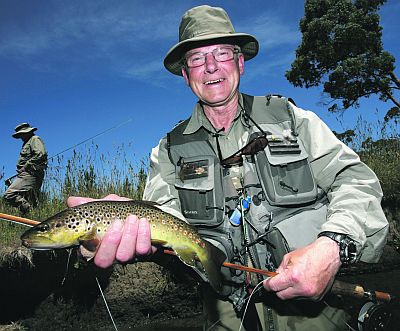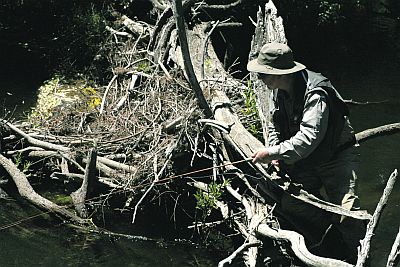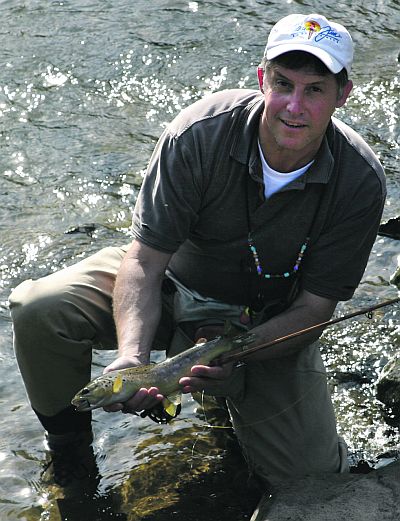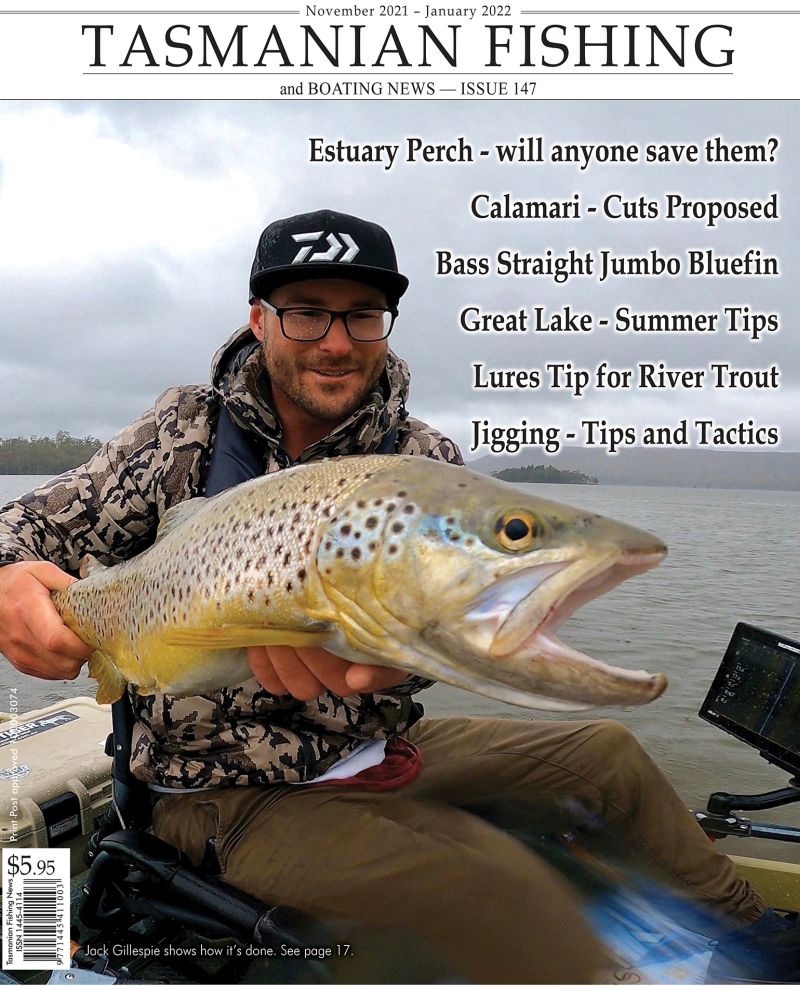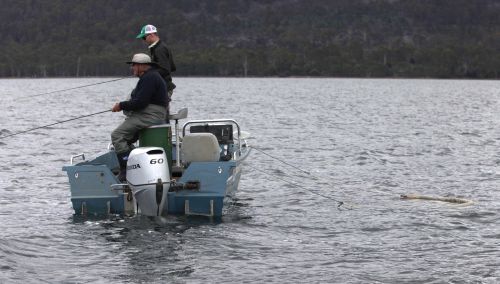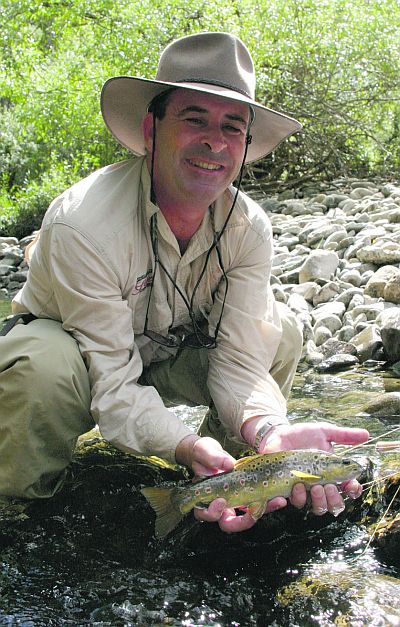 Small streams are sweet
Small streams are sweet
Mike Stevens gives some tips about fishing small streams for little fish.
I don’t particularly chase big fish. I like to catch them of course, but often I would rather catch ten small trout in a stream, rather than one big trout in a lake.
Recently I had some Victorian friends over and they also love the small northern streams. Fishing these predominately with small dry flies is such fun I can barely even begin to describe it. Most headwater streams have enough water and the eager little trout will come up and inspect your offerings.
Start late—finish whenever
There are real bonuses of this style of stream fishing and the first that comes to mind is the timing of your fishing day. You don’t need to start early and probably don’t need to be on the water until midday. This allows the temperature to rise and terrestrial insects to start moving about. If they end up on the water the trout soon find them. And rising trout will also find your little fly as well.
It can get too hot at this time of the year, and a shady tree is a welcome spot to take a break. Sit back and eat some lunch, have a cold drink and just watch. The fish can sometimes take a break as as well as the heat gets too much for them. As the day starts to cool the fish start again and on evening caution can be thrown to the wind as the big fish come out to feed. John Diggle - the Inland Fisheries Director told me once of the big fish he had seen in the St Pats River. ‘They come out just on dusk’ he said. ‘They feed for about twenty minutes, and it is the only time you see the big fish. These are monsters too - up to three and four pounds.’
I wonder if all the small streams are the same when it comes to John Diggle’s observaton? It probably is where there is enough cover and enough water.
More than fish
Little streams have an abundance of wildlife other than trout and as I sat recently a deer came down to drink as a platypus was nosing around looking for food. We live in a special place. The fallow deer, like trout was introduced, but it seems so much at home. I was just a few metres away and downwind, and sitting motionless was not even noticed.
Small streams usually offer excellent protection from the strong sea breezes we get later on Summer days so generally you are not battling with the wind all day. You still need to work with the wind though especially in the tiny creeks where even being 3-400 mm off line will have your fly in the grass, not on the water.
Leaders
The construction of your leader is vital in this regard as well. It needs stiffness in the butt to turn the fly over, but needs a tippet that is long and limp enough to give you a drag free drift. My favourite leader is a 4x Cortland Precision with 40-50 cm cut off the butt and then I add some tippet. I use either 5X (4.9 pound) Cortland Precision or four pound Maxima. These are both good, tough and strong lines that have good knot strength. I vary the length of the tippet as needed during the day depending on the water.
You need to be able to roll cast and bow and arrow cast and turn the fly over at the end. You don’t need to cast 15 metres, but no one is disadvantaged if they can cast that far. You need every cast in the book fishing these streams and accuracy is vital. Yes I know little fish will sometimes - often in fact rush your fly when it lands, but you have to have line control. Perhaps the most important part of line control is what is behind you rather than in front. Mostly you won’t get the luxury of open areas for a long back cast, and often you will have to curve cast under a branch, drop it through a narrow slot or roll cast away from a vertical backdrop. Accurate stream casters will catch four times more fish than those that struggle.
I put my less than brilliant distance casting down to too much wrist action casting on streams. I can cope with that.
Flies
I use a few different flies from beetles, to Red Tags, Royal Wulffs and little hoppers. The hoppers this time of the year work really well as the real things become more active. These are certainly more effective on the streams meadow streams where grass is closeby, rather that the streams that filter through mini rainforests.
One of the best all round flies I have found is called a Sharpies Thredbo Special - brown in size 16. It is a Klinkhammer style emerger pattern that hangs half under water supported by a parachute hackle. It is rarely refused by a feeding trout and I have caught more than 20 fish on a single fly. Other great flies I am more than happy to use are small Bibio Hoppers, Red Tags (a bit fragile) and Royal Wulffs. When the fish are really hard I do put on a little Pheasant Tail nymph. I do this reluctantly, but not because I am anti-nymph – I just love seeing a trout put its head over the top of a fly.
In Summer when the sun is high most fish can be spotted and I love seeing them take – or even refuse a fly. Little fish can be quite fickle though and just like their big New Zealand cousins they can treat your fly with disdain — just take a look and drift off. When this happens I have sometimes spent half an hour changing flies repeatedly, getting 15-20 refusals. This is when a nymph eventually gets a run – trying to catch a tiny trout off guard. This is a battle between a 20 centimetre trout with a very small brain and a geared up fishing machine. I love it and wonder if anyone else thinks the same way.
Rods
My favourite rod has become a 6’ 6” #3 Vision and it is a beauty. It is not expensive, but the performance is superb. As explained earlier the little streams are generally wind protected by bankside growth and a little rod like this is essential to get under the trees. There are some fabulous little Sage rods as well and I have them too. Sometimes I use a Peter McKean cane rod and I just love that, but tend to use it on more open streams rather than the ones I have to bush bash through. It is very tough, but I worry about breaking it.
Finding streams
I am not going to give you any names. If you are keen you will find plenty. Hobart has its share, the northeast has heaps and the north across to the northwest has plenty as well. My suggestion is to look at streams that flow into our larger streams and rivers. Headwaters of the bigger rivers and streams are well worth a look, and if they start in a temperate/rain forest take a very close look. Drive around a lot and then walk a lot. You are looking for places that no one else fishes. Check out the maps and Google Earth places as well. I must warn though Google Earth is not so hot for finding small streams as the overhanging canopy often hides a treasure trove of water beneath it.
One your own - or with a mate
A big question this one—especially when you have discovered a secret spot. You take a mate there and then he does the same. In a few months there is a well worn track and one day you arrive all keen on tricking tiny trout and there is a car parked exactly where you park. It is a little gut wrenching when you realise it is because you shared it. But fishing with a mate can be great – pool hopping or fish hopping – taking it in turns to catch fish. Get serious and you have to hand the rod over when you miss a strike.
On your own can be just the best therapy in the world. A stressfull day or week will be well and truely forgotten as you concentrate on getting a bow and arrow cast up under a tree. You can skip a pool, fish fast or slow, or just sit and watch, catch heaps - or catch none.
Re-discovering the magic
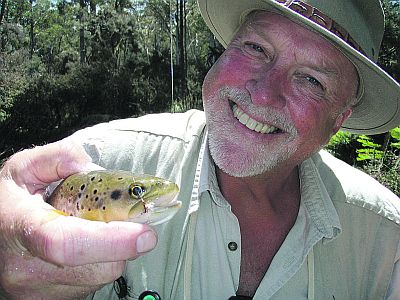 Rex Hunt rang me recently and told me he had re-discovered the magic of small trout and fly fishing streams. ‘Michael, he said, ‘can you point me to a couple of little Tassie streams. I want to come over for the day and catch a few little trout.’
Rex Hunt rang me recently and told me he had re-discovered the magic of small trout and fly fishing streams. ‘Michael, he said, ‘can you point me to a couple of little Tassie streams. I want to come over for the day and catch a few little trout.’ ‘No way’, I said ‘I’ll take you’. Rex has helped me enormously with two launches for books I published for David Scholes—Rex’s fishing hero.
I took him to some great spots and we caught heaps—and not one big enough for even a breakfast fish. We hooted and laughed, ate a beautiful lunch and shared an ice cold beer. Rex had arrived mid morning and after a day of fishing caught a 6.30 pm plane home—he had the time of his life.
Rex has done a huge amount for fishing. He brought fishing to the forefront for many people. His fabulous TV programs changed many anglers mindset to conservation, whilst not discouraging them from keeping a feed for the table. He entertained like no has done since—and if you have ever fished or filmed with him you will know there is no one better at either. His live to camera work is awesome.
Not much gear required
One great thing about the small stream caper is you don’t need much tackle—a box of flies, floatant, some tippet material, cutters/forceps, polaroids, a hat and that’s about it. Of course you can have heaps more, but it is not really needed. I used to take several boxes of flies because I scrounged them out my huge bag of fly gear where there are boxes for emergers, another for hoppers, another for nymphs, then there’s the wets and others—you get my drift. So what I did was just organise one box with a few of everything. It is only a small box, but it has everything I need and if it doesn’t the fish will just have to change their diet.
I put the tools on a fancy fishing necklace and it works really well. The other really useful piece of kit is a piece of amadou. It used to be common, but not sure if you can still get it.
Amadou is a fungi that looks like a piece of chamois leather. It is fantastic for drying out soaked flies—especially wet and slimy flies you have just caught a fish on. See if you can find some. Mine is a Marc Petitgean product.
Advice from David Scholes
David Scholes loved the little streams. They were the place he learned to fish—the Upper Yarra and tributaries, and then later Tasmania. He especially enjoyed the small northern streams and often chatted to me about as we sat in his sunroom.
He pointed out with great passion the importance of getting in the right position. ‘There is always a best position’ he said. ‘Take note of the flow and eddies and set yourself up so drag doesn’t ruin your drift.’
I often think of his wise words—especially when I muck it up.
He said to me ‘it is not how big a fish you catch that makes you a satisfied fly fisher, but how small a fish you can catch and give you joy.’ Hear hear.
A little note to end: Beware of snakes. There are a few around. I wade wet in these little streams, but tread carefully. Best idea is to wear some lightweight waders, or at least some gaiters for a bit of protection and carry a couple of compression bandages.
Mike Stevens
